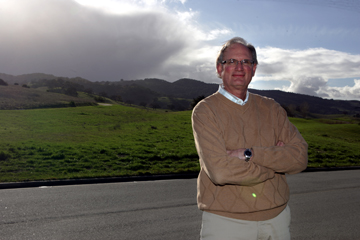
An 80-acre property slated for future affordable housing
project
An 80-acre parcel in an undeveloped section of Park Hill is the
future site of an affordable housing development.
An 80-acre property slated for future affordable housing project
An 80-acre parcel in an undeveloped section of Park Hill is the future site of an affordable housing development.
“We’re negotiating a purchase agreement for the property,” said Jan Lindenthal, director of housing development and construction at South County Housing. “A purchase agreement means that we would be purchasing it at some point in the future, and then yes, developing it.”
Scott Fuller, a partner on the project and the Brigantino family optioned the property from the Hart family, Fuller said. They are working on a contract with staff from South County Housing, he said.
The project would provide, “some much needed affordable housing,” said Dave Brigantino.
Fifty percent of the units would be affordable, Lindenthal said.
Staff from South County will use community input to determine what kind of units the project would include, she said.
“We will be looking for input from the community on that,” Lindenthal said. “We’ve heard both things, affordable rental housing and affordable housing to purchase.”
It is too early in the process to determine a number of units, she said.
“We’re still assessing how much of the land is developable, because of the slope and all of that,” she said.
There have been preliminary discussions with city officials, Fuller said. Staff from South County Housing let city officials know they were interested in developing the parcel, he said.
Staff from South County will be ready to submit an application to the planning department later this year, Lindenthal said. Fuller and the Brigantino family wanted to do a high-density project with a high level of affordable housing, he said.
“We thought they’d be the best developer to do that,” Fuller said. “We were really impressed with some of the projects they have done.”
Brigantino agreed.
“We had several opportunities with different builders, and we thought South County was the best fit,” he said.
Negotiations have been ongoing for about 10 months, Lindenthal said.
“It’s walking distance from downtown,” Brigantino said. “We need bodies downtown.”
One complication is that part of the property is in the city and part is in the county, Fuller said.
Staff from South County have handled projects with similar issues, Lindenthal said.
“It’s essentially an agreement between the two governments that says this is how we want to see this property governed,” she said.
The issues would include whether city or county staff would take the lead on the application process, and if the project would use the city or county to provide services, she said.
The property was originally offered to Gavilan College officials as the site of the new San Benito County campus, Fuller said.
“We did talk to Gavilan, and it didn’t work out for them,” he said. “It didn’t fit their parameters.”
Asked how much the property was offered to officials from Gavilan, Brigantino said, “We offered it to them at a very fair price, and it just didn’t fit their criteria.”
Another complication with the property is that the parcel has no access to North Street.
City officials planned to extend North Street through Park Hill, said Clint Quilter, Hollister’s city manager. The bulk of the funds that city officials had available for road construction were used on the Hwy. 25 bypass, he said.
After the sewer moratorium ends and new development begins, the city will collect traffic impact fees on new construction.
The first priority for traffic impact fees will be the North Street extension, Quilter said. Construction could begin between 12 and 18 months after the moratorium ends, he said.
The extension would “complement” their project, Brigantino said.
Tod duBois, a local developer who owns a two and a half acre parcel on Park Hill, disagreed.
“There is a basic tie between the North Street Project and the Hart project,” duBois said.
Without the extension, the property is “undevelopable,” he said.
“Somebody has got to put North Street through,” duBois said. “If the city can get somebody else to do that, the city would want to do that.”
His project would be too small to support the extension, duBois said.
On his parcel, duBois is planning senior cohousing with some retail for small businesses.
“It would make small businesses and cafes a lot more suited to the area if North Street goes through as designed,” he said. “If the Hart project is a big affordable housing project, then the mixed use would be a better fit.
If, in the next 10 years, the Hart property is not developed and North Street is not extended, then duBois would, “go with a more residential model.”
As planned, North Street would run between the duBois and Hart property, he said.
“They have a big four lane highway basically through that,” duBois said, “which I think should have more curves and be a more scenic drive than is currently planned.
Staff from South County have “extensive experience” dealing with undeveloped properties, Lindenthal said.
“We’ve worked on lots of projects were we have to extend streets and extend power lines and all that,” she said.
Referring to Los Arroyos in Gilroy, Lindenthal said, “It had extensive infrastructure needed to develop it, and it’s now a 62-acre community.”
Staff from South County would use input from the community, including residents and elected officials, to determine the design of the project, the scope of the affordable housing and the needs of those the affordable housing would serve, she said.
“We think that’s the part that really makes a project successful,” Lindenthal said.









